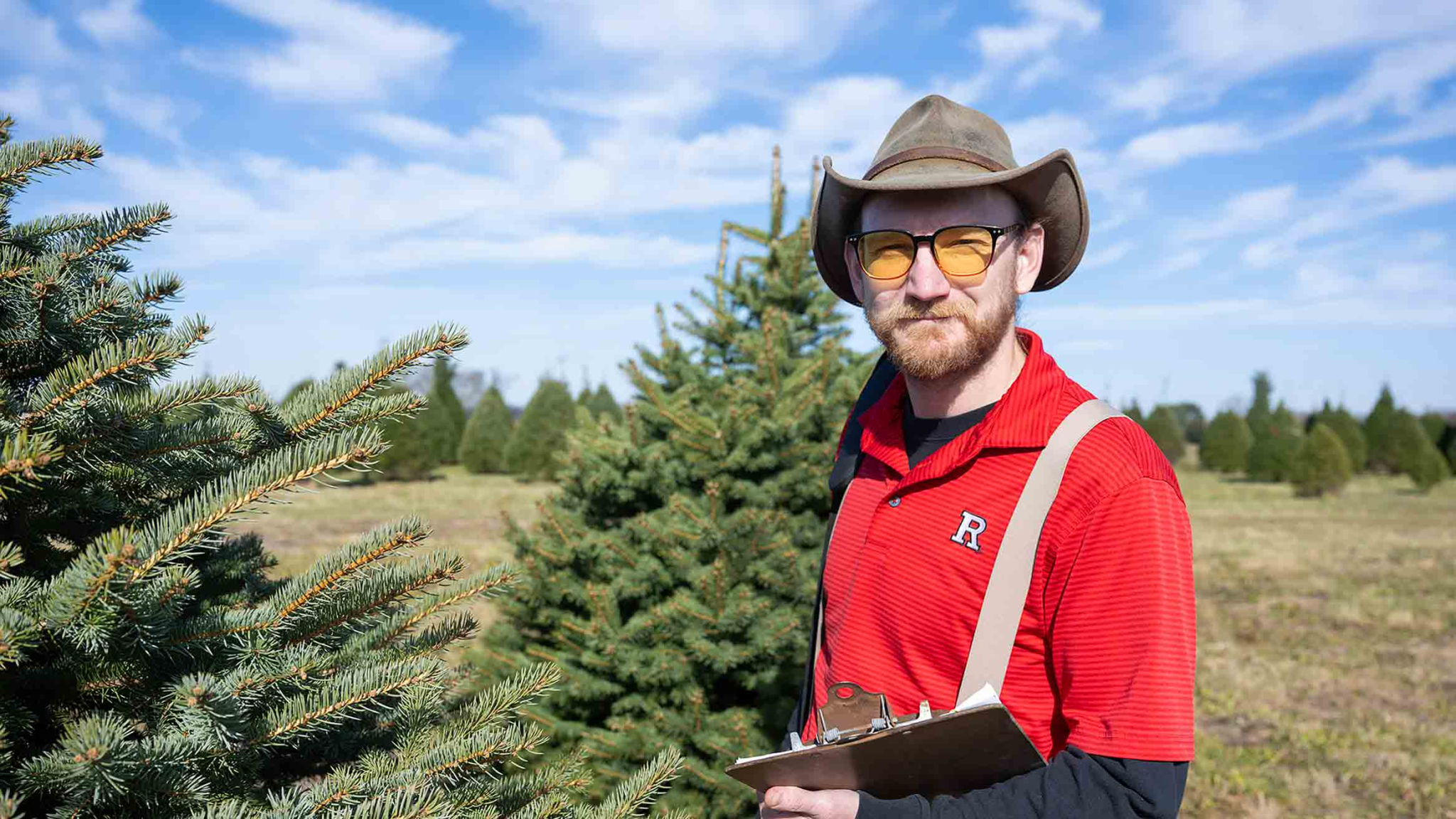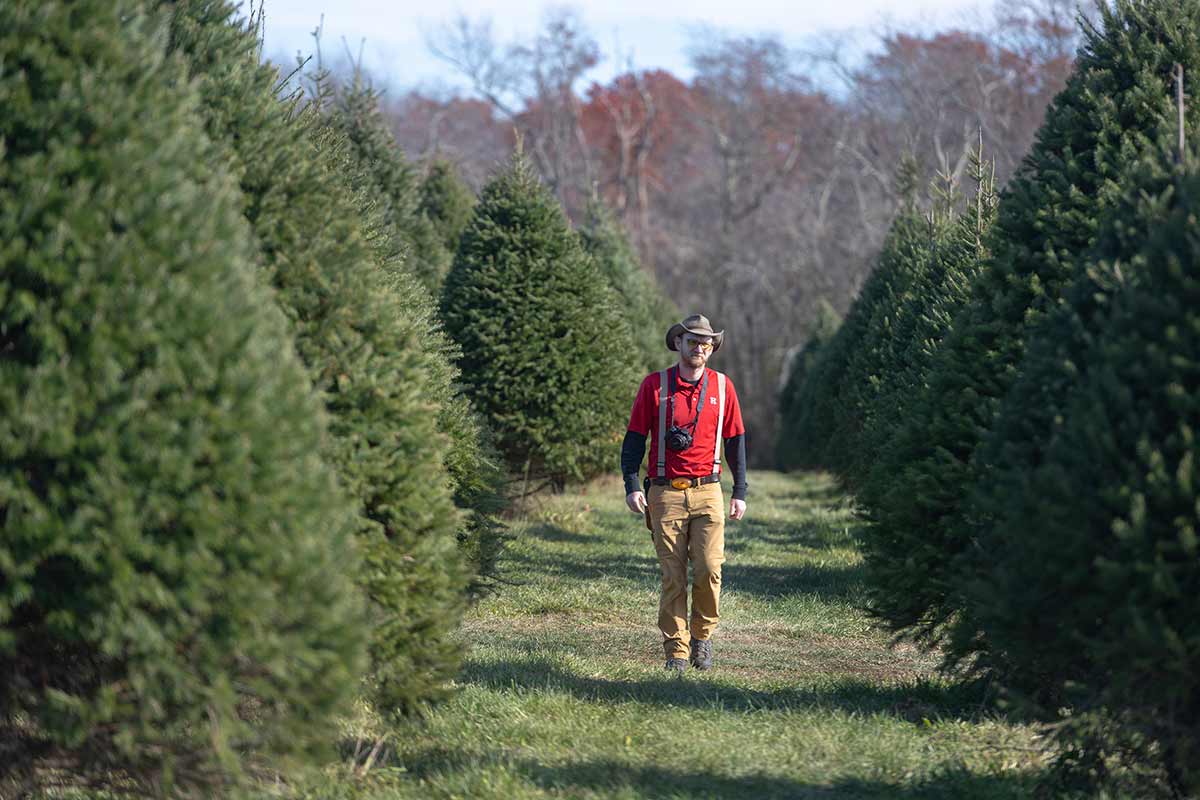
New Jersey Christmas tree farms and nurseries offer a bevy of beautiful choices for anyone looking for the perfect tree, says Rutgers evergreen researcher Timothy Waller. Photo credit: Nick Romanenko.
If you are heading to a farm or the local lot after the Thanksgiving weekend to pick out your perfect Christmas tree, Timothy Waller, an evergreen researcher, has some advice for you.
Waller, an agricultural agent with Rutgers Cooperative Extension of Cumberland County, has been working on Christmas tree disease management and variety demonstrations as part of his ornamental research efforts.
The Rutgers School of Environmental and Biological Sciences faculty member, who earned his doctoral degree in plant pathology from Rutgers in 2019, spends time providing practical insights and performing research for the state’s tree farmers. Here is what he has to say about picking out your tree this year.
Is there such a thing as the perfect Christmas tree?
The adage “beauty is in the eye of the beholder” really applies here. But there are useful parameters. Does the tree fulfill your vision for a festive holiday aesthetic? Can its branches bear the weight of ornaments and lights? Is its scent appealing? Is it properly watered so it will retain its needles through the holiday season?
Whether a person is going to a tree farm or purchasing a precut tree, what should a person look for?
If you’re cutting your own tree, make sure at least three sides of the tree are full, without large gaps in the arrangement of branches and needles so it will look verdant if you place it in a corner. Also, look for trees where the top has strong leaders – vertical branches – about 6 inches high. This will give you space to trim the leader to hold the tree topper.
Whether a tree is cut by you or precut, the appearance of bright, shiny needles and the ability of a tree to retain them are tied to its moisture level. It’s important to retain this to guard against flammability and maintain a clean tree area. When selecting any tree, gently pull your fingers through the branches. If many needles come off in your hands, this means the tree will likely not hold the needles for the duration of the holiday. This is especially important with precut trees as they may or may not have sufficiently been placed in water.
When choosing a tree in a precut lot, lift multiple trees of the same type and size. The heaviest is the most hydrated and will likely hold needles the longest.

Rutgers scientist Timothy Waller surveys evergreens at the Rutgers Agricultural Research and Extension Center in Millville, Cumberland County, where he grows and studies a host of varieties to serve the state’s community of tree farmers. Photo credit: Nick Romanenko
What are some of the best varieties to choose from? Do you have a favorite?
There are so many exciting Christmas tree varieties that our New Jersey farms now have available. And remember to appreciate what you see: It takes 7 to 12 years to grow a tree.
Traditional options include Colorado Blue Spruces, Norway Spruces, Douglas Firs, Fraser Firs, Balsam Firs, and Noble (aka Grand) Firs. Other classics include White Spruces, Meyers Spruces, and Scotch Pines. Recently, Concolor (aka White) Firs and Canaan Firs have become very popular. State tree farmers also are offering selections of Red Cedars, White Pines, Austrian Pines, Serbian Spruces, Black Hills Spruces, Korean Firs and Fralsam Firs, a cross of the Fraser and Balsam varieties. Nordman and Turkish Firs are becoming increasingly popular among growers. They are highly resistant to the devastating Phytophthora root rot disease, which is central to my research.
I am partial to the Concolor Fir for its unique color, growth habit and appealing citrus scent. I also like the Canaan Fir for its classic pyramidal shape that just feels like Christmas. This fir is also more resistant to some pest issues and root diseases.
As a Rutgers scientist, what are some of the scientific mysteries you are exploring?

At his research lab in Millville, scientist Timothy Waller studies plant insect pests and soil pathogens causing crown and root rot diseases. Photo credit: Nick Romanenko.
I study plant insect pests and soil pathogens causing crown and root rot diseases. Root diseases represent the biggest challenge in growing conifers nationwide. I also study the effectiveness of various fungicides, in lab and field experiments.
I am preparing ground to plant roughly 15 different varieties of Christmas trees at the research center. This means I acquired bareroot seedlings from the same distributors that our New Jersey growers are using to plant their fields. I potted them into containers ranging from small 6-inch tap root-promoting pots to large 14-inch-tall thin tree pots. I allowed them to grow in high tunnels under irrigation, shade cloth and with tightly managed nutrient loads. They will be planted in the field early next spring. My goal is to give Christmas tree and nursery growers, master gardeners and the public an opportunity to see all the cool varieties we have available.
County agent Bill Errickson of the Rutgers Cooperative Extension of Monmouth County has been an excellent co-principal investigator and integral to this work. He plans to install similar demonstration trials in the Rutgers research plots in Cream Ridge, so we can show more growers and compare our research findings.
Why do you do what you do?
My first experience with an agricultural agent was when I was helping on my best friend’s farm, and he was dealing with a season-crippling bacterial issue on his tomatoes. A Rutgers Cooperative Extension agent, the late Ray Samulis, came to visit and help mitigate the problem. Since then, I have been hooked on the idea of leveraging science to help our nation’s most important businesses and families: our farmers.
Are there additional resources, should a person want to find a tree farm in New Jersey or start a farm?
For more information, visit the New Jersey Christmas Tree Growers Association website and use their “Find a Farm” tool that allows a search by county. For a more detailed discussion, listen to our Rutgers Ask the Agent Christmas Tree podcast.
If you are a grower or interested in becoming one, contact the NJ Christmas Tree Growers Association. Additionally, we started a new Christmas Tree Edition of the Rutgers Plant and Pest Advisory that will continue to provide up-to-date information on pests, diseases, and agriculture-related information and updates.

